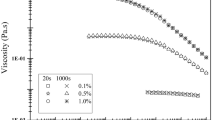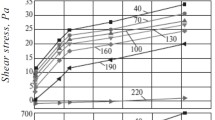Abstract
In this study, a new zwitterionic polymer viscosity reducer (HP-THIN) was designed to address the issue of viscosity increases in high-temperature and high-density water-based drilling fluids. HP-THIN is specifically formulated for ultra-high temperatures and optimized using the viscosity reduction index before and after thermal aging. The molecular structure, thermal stability, and viscosity-average molecular weight of HP-THIN were characterized using FTIR, TGA, and rheometric analysis using a Ubbelohde viscometer. The viscosity-reducing performance of HP-THIN was evaluated in various types of drilling fluid-based slurries at 220 °C, including fresh-water slurry, brine slurry, calcium-containing slurry, and high-density composite brine slurry. Furthermore, HP-THIN was compared to commercial viscosity reducers such as Polythin and xy-27. At optimal dosage of 0.3 wt.% at 220 °C, HP-THIN demonstrated excellent viscosity reduction rates of 86%, 72%, 73%, and 51% in fresh-water slurry, brine slurry, calcium-containing slurry, and high-density composite brine slurry, respectively. HP-THIN exhibited superior viscosity reduction index in all drilling fluid slurries, compared to Polythin exhibiting reduction index of 86%, 64%, 30% and -17.8% while xy-27 achieved reduction rates of 83.3%, 56%, 55% and 37.8%. The excellent viscosity reduction performance of HP-THIN makes it a promising candidate for practical applications in the oil and gas industry.











Similar content being viewed by others
Data availability
Data will be made available on request.
References
Su Y, Lu B, Liu Y, Zhou Y, Liu X, Liu W, Zang Y (2020) Status and research suggestions on the drilling and completion technologies for onshore deep and ultra deep wells in China. Oil Drill Prod Technol 42(5):527–542. https://doi.org/10.13639/j.odpt.2020.05.001
Xie B, Tchameni AP, Luo M, Wen J (2021) A novel thermo-associating polymer as rheological control additive for bentonite drilling fluid in deep offshore drilling. Mater Lett 284:128914. https://doi.org/10.1016/j.matlet.2020.128914
He Y, Zheng Y, Wu B (2023) Analyses and research on the influencing factors of Deep and Ultra-deep cementing whole process. Technol Superv Petroleum Ind 39(03):1–3. https://doi.org/10.20029/j.issn.1004-1346.2023.03.001
Wang H, Huang H, Bi W, Ji G, Zhou B, Zhuo L (2022) Deep and ultra-deep oil and gas well drilling technologies: Progress and prospect. Nat Gas Ind B 9(2):141–157. https://doi.org/10.1016/j.ngib.2021.08.019
Shen H, Sun J, Lyu K, Huang X, Liu J, Wang J, Bai Y, Jin J (2022) Research Progress and Application prospects of Intelligent Organic Treatment Agent for Water-based Drilling Fluid. Oilfield Chem 39(01):155–162. https://doi.org/10.19346/j.cnki.1000-4092.2022.01.027
Yang X, Shi X, Meng Y, Xie X (2020) Wellbore stability analysis of layered shale based on the modified Mogi–coulomb criterion. Petroleum 6(3):246–252. https://doi.org/10.1016/j.petlm.2019.11.002
Aftab A, Ismail AR, Lbupoto ZH, Akeiber H, Malghani MGK (2017) Nanoparticles based drilling muds a solution to drill elevated temperature wells: a review. Renew Sustain Energy Rev 76:1301–1313. https://doi.org/10.1016/j.rser.2017.03.050
Jiang G, Ni X, Li W, Quan X, Luo X (2020) Super-amphiphobic, strong self-cleaning and high-efficiency water-based drilling fluids. Pet Explor Dev 47(2):421–429. https://doi.org/10.1016/S1876-3804(20)60059-3
Pang S, Zhu H, Ma J, Zhao L, Yang C, An Y (2022) Sulfonated sodium tannin and AM/AMPS copolymer complex as an anti-temperature viscosity reducer for water-based drilling fluid. Energy sources, part. Recovery Utilization Environ Eff 44(4):9827–9843. https://doi.org/10.1080/15567036.2022.2143961
Li Q, Zhao Q, Dai H, Huang R, Liang B, Zhang X (2014) Synthesis and characterization of Calcium Lignosulfonate grafted with p-Styrenesulfonate and maleic anhydride. Polym Mater Sci Eng 30(2):72–76. https://doi.org/10.16865/j.cnki.1000-7555.2014.02.015
Huang W, Zhao C, Qiu Z, Leong YK, Zhong H, Cao J (2015) Synthesis, characterization and evaluation of a quadripolymer with low molecular weight as a water-based drilling fluid viscosity reducer at high temperature (245oC). Polym Int 64(10):1352–1360. https://doi.org/10.1002/pi.4923
Xie J, Li B, Zhang B (2013) Synthesis and properties evaluation of ultra-high density drilling fluid dispersant. Chem Eng Oil Gas 42(05):496–500. https://doi.org/10.3969/j.issn.1007-3426.2013.05.012
Kuang S, Pu X, Liu Y (2010) Principles of controlling wall building properties of ultra-high-density water-based drilling fluid. Drill Fluid Completion Fluid 27(5):8–11. https://doi.org/10.3969/j.issn.1001-5620.2010.05.003
Zhang G, Wang S, Shi P (2000) Research and applications of viscosity reducers for drilling fluids in China. Oilfield Chem 1:78–82. https://doi.org/10.19346/j.cnki.1000-4092.2000.01.022
Zhang C, Liu S, Liu S, Yuan Y, Qian F, Li W, Duan M (2023) Preparation and performance evaluation of Zwitterionic Polymer Viscosity Reducer. Oilfield Chem 40(01):7–11. https://doi.org/10.19346/j.cnki.1000-4092.2023.01.002
Wang G, Wu Y, Liu D, Duan C (2015) Synthesis and performance evaluation of thinner for drilling fluid used at high temperature and salt. Appl Chem Ind 44(10):1897–1900. https://doi.org/10.16581/j.cnki.issn1671-3206.2015.10.029
Hermoso J, Martinez BF, Gallegos C (2014) Influence of viscosity modifier nature and concentration on the viscous flow behaviour of oil-based drilling fluids at high pressure. Appl Clay Sci 87:14–21. https://doi.org/10.1016/j.clay.2013.10.011
Ujma KHW, Plank JP (1989) A new calcium-tolerant polymer helps to improve drilling-mud performance and to reduce costs. SPE Drill Eng J 4:41–46. https://doi.org/10.2118/16685-pa
Wang L, Sun G, Li D, Xia H, Li W, Xu T, Zhang H (2021) Performance of New Salt-resistant polymer solution and evaluation of Oil Displacement Effect. Mater Rev 35(1B):02171–02177. https://doi.org/10.11896/cldb.19070048
Zhu Y, Guo Y, Xu H, Pang X, Li H (2021) Preparation and performance evaluation of Hydrophobically associating polymer with temperature resistance and salt tolerance. Oilfield Chem 38(02):317–323. https://doi.org/10.19346/j.cnki.1000-4092.2021.02.022
Jia M, Huang W, Qiu Z, Jiang L, Cao J, Zhong H, Mao H (2015) Synthesis and evaluation of Polymer Viscosity Reducer with Ultra-high temperature (240oC) and salt tolerance. Chem Reagents 37(12):1067–1072. https://doi.org/10.13822/j.cnki.hxsj.2015.12.003
Mann PJ, Wen S, Xiaonan Y, Stevenson WTK (1990) A modified ubbelohde viscometer with improved dilution characteristics. Eur Polymer J 26(4):489–491. https://doi.org/10.1016/0014-3057(90)90059-D
Uspenskaya MV, Deĭneka GB, Sirotinkin NV (2006) A multivariate analysis of the IR spectra of tetrazole-containing copolymers. Opt Spectrosc 100:204–208. https://doi.org/10.1134/s0030400x06020093
Baloch MK, Khurram MJZ, Durrani GF (2011) Application of different methods for the thermogravimetric analysis of polyethylene samples. J Appl Polym Sci 120(6):3511–3518. https://doi.org/10.1002/app.33538
Li Q, Zhao Q, Dai H, Liang B, Zhang X (2014) Synthesis and characterization of Calcium Lignosulfonate grafted with p-Styrenesulfonate and maleic anhydride. Polym Mater Sci Eng 30(02):72–76. https://doi.org/10.16865/j.cnki.1000-7555.2014.02.015
Xie Y, Lu L, Zhang S, Pan B, Wang X, Chen Q, Zhang W, Zhang Q (2011) Fabrication of anion exchanger resin/nano-CdS composite photocatalyst for visible light RhB degradation. Nanotechnology 22(30):305707. https://doi.org/10.1088/0957-4484/22/30/305707
Tan X, Liu F, Hu L, Reed AH, Furukawa Yoko, Zhang G (2017) Evaluation of the particle sizes of four clay minerals. Appl Clay Sci 135:313–324. https://doi.org/10.1016/j.clay.2016.10.012
Ma J, Pan Y, Yu P, An Y (2019) Research Progress on Shale inhibitors at Home and abroad in recent ten years. Oilfield Chem 36(01):181–187. https://doi.org/10.19346/j.cnki.1000-4092.2019.01.034
Zhang T, Ge J, Wu H, Guo H, Jiao B, Qian Z (2022) Effect of AMPS (2-acrylamido-2-methylpropane sulfonic acid) content on the properties of polymer gels. Pet Sci 19(2):697–706. https://doi.org/10.1016/j.petsci.2022.01.006
Ma J, Yu P, Xia B, An Y (2019) Effect of salt and temperature on molecular aggregation behavior of acrylamide polymer. E-Polymers 19(1):597–606. https://doi.org/10.1515/epoly-2019-0063
Dong Z (2021) Development and evaluation of temperature and salt resistant polymer viscosifier. Oilfield Chem 38(01):29–33. https://doi.org/10.19346/j.cnki.1000-4092.2021.01.006
Dong W (2014) Synthesis and performance evaluation of a new polymer thickener resisting to high temperature and salt. J Xi’an Shiyou Univ (Natural Sci Edition) 29(05):75–79. https://doi.org/10.3969/j.issn.1673-064X.2014.05.015
Dou L, Zhu Y, Ji Y (2021) Synthesis and Solution properties of AM/PTDAB/AMPS/NaAA Quaternary Copolymer. Oilfield Chem 38(01):119–124. https://doi.org/10.19346/j.cnki.1000-4092.2021.01.022
Li X, Xie B, Zhao L (2018) Synthesis and evaluation of new heat-resistant and salt-tolerant polymer viscosifier. Petrochemical Technol 47(6):595–599. https://doi.org/10.3969/j.issn.1000-8144.2018.06.012
Huo J, Yu B, Xu X, Che Y, Zhang J, Zhang X, Zhang R (2023) Design, synthesis and functional enhancement mechanism of heat-resistant and salt-resistant hydrogel. J Xihua University(Natural Sci Edition) 42(3):59–70. https://doi.org/10.12198/j.issn.1673-159X.4789
Zhang Y, Qu Y, Zhang Z, Cheng R, Yang Z (2022) Research Progress and Development Direction of Technologies for Water-based Drilling Fluid in Ultra-high temperature. Oilfield Chem 39(03):540–547. https://doi.org/10.19346/j.cnki.1000-4092.2022.03.027
Ji T, Song L, Wei K, Wang X (2019) Study on influence factors of mud cake permeability. Chem World 60(11):804–811. https://doi.org/10.19500/j.cnki.0367-6358.20180520
Chen G, Lei J, Du Y, Du Y, Chen X (2018) A polycarboxylate as a superplasticizer for montmorillonite clay in cement: Adsorption and tolerance studies. Arab J Chem 11(6):745–755. https://doi.org/10.1016/j.arabjc.2017.12.027
Yang Y, Rong K, Xu S, Li J, Yu Y, Li J (2018) Synthesis and performance of a polyampholyte inhibitor. Chem Ind Eng Progress 37(06):2370–2377. https://doi.org/10.16085/j.issn.1000-6613.2017-2373
Fang J, Niu X, He Z, Bao J, Wang G (2017) Research and evaluation of zwitterionic film forming sealing agent used in drilling fluids. Appl Chem Ind 46(02):234–239. https://doi.org/10.16581/j.cnki.issn1671-3206.2017.02.015
Chang W, Leong YK (2014) Ageing and collapse of bentonite gels-effects of Li, na, K and Cs ions. Rheol Acta 53:109–122. https://doi.org/10.1007/s00397-013-0744-0
Du L, Yang F, Mu Y, Yu R, Zuo J, Gao J, Yu X, Teng L, Tang X (2014) Evaluation of the Acute toxicity of Pharmaceutical Wastewater to luminescent Bacteria. Environ Sci 35(01):286–291. https://doi.org/10.13227/j.hjkx.2014.01.041
Kang W, Zhang L, Meng L, Peng S (2012) The study of static adsorption of the amphiphilic polymer on rocks and minerals. Appl Chem Ind 41(11):1865–1867. https://doi.org/10.16581/j.cnki.issn1671-3206.2012.11.040
Zhang Y, Xie K, Kang X, Li Q, Jiang X, Deng X (2016) Research on Static Adsorption and Desorption of Hydrophobic associating polymer AP-P4 under the formation Condition of SZ36-1 Reservoir. Oilfield Chem 33(3):468–476. https://doi.org/10.19346/j.cnki.1000-4092.2016.03.018
Pang S, An Y, Ma J, Zhao L, Yang C (2022) Development and performance evaluation of high temperature resistant viscosity reducer SMT/AMPS. Appl Chem Ind 51(08):2194–2199. https://doi.org/10.16581/j.cnki.issn1671-3206.20220831.008
Zhang G, Wang S, Shi P (2000) Researches and applications of viscosity reducers for drilling fluids in China. Oilfield Chem 01:78–81. https://doi.org/10.19346/j.cnki.1000-4092.2000.01.022
Nieto-Alvarez D, Zamudio-Rivera L, Luna-Rojero E, Rodríguez-Otamendi D, Marín-León A, Hernández-Altamirano R, Mena-Cervantes V, Chávez-Miyauchi T (2014) Adsorption of zwitterionic surfactant on limestone measured with high-performance liquid chromatography: micelle-vesicle influence. Langmuir 30(41):12243–12249. https://doi.org/10.1021/la501945t
Loretta Y, Raymond S (2011) The role of clay minerals and the effect of H+ ions on removal of heavy metal (Pb2+) from contaminated soils. Can Geotech J 37(2):296–307. https://doi.org/10.1139/t99-106
Li J, Wang Z, Hu A (2011) Application progress of Water-Soluble Amphoteric polymers in Oil Field Development. Oilfield Chem 28(02):229–235. https://doi.org/10.19346/j.cnki.1000-4092.2011.02.027
Pang S, An Y, Ma J (2022) Research progress of domestic drilling fluid viscosity reducer in recent ten years. Drill Eng 49(1):96–103. https://doi.org/10.12143/j.ztgc.2022.01.013
Lu Li, Samanvaya S, Meng S, Jeffrey M, Matthew V (2020) Effects of Non-electrostatic Intermolecular interactions on the phase behavior of pH-Sensitive polyelectrolyte complexes. Macromolecules 53(18):7835–7844. https://doi.org/10.1021/acs.macromol.0c00999
Acknowledgements
We would like to thank the financial support from Sinopec Key Laboratory of Enhanced Oil Recovery for Fractured Vuggy Reservoirs for this work.
Funding
Supported by the Foundation of Development of thermo-responsive-self-adaptiveness Janus nanoparticle and its shale plugging mechanism (No. 52150410427).
Author information
Authors and Affiliations
Contributions
Hu Deng: Conceptualization, Data curation, Formal analysis, Funding acquisition, Methodology, Writing – original draft. Huaizhi Tao: Investigation, Visualization, Writing – review & editing. Jiawei Ai: Investigation, Visualization, Writing – review & editing. Jindong Chen: Project administration. Binqiang Xie: Resources, Supervision, Lesly Dasilva Wandji Djouonkep: Validation, revision.
Corresponding author
Ethics declarations
Conflicts of interest
The authors declare that they have no conflict of interests.
Additional information
Publisher's Note
Springer Nature remains neutral with regard to jurisdictional claims in published maps and institutional affiliations.
Supplementary Information
Below is the link to the electronic supplementary material.
10965_2024_3921_MOESM1_ESM.docx
The file contains information on the orthogonal experimental procedure, the effect of shear rate on viscosity, environmental and biological toxicity evaluation, the effect of HP-THIN and filtration loss reduction agent, and the cost-affordability of HP-THIN as supporting information. (DOCX 98 KB)
Rights and permissions
Springer Nature or its licensor (e.g. a society or other partner) holds exclusive rights to this article under a publishing agreement with the author(s) or other rightsholder(s); author self-archiving of the accepted manuscript version of this article is solely governed by the terms of such publishing agreement and applicable law.
About this article
Cite this article
Deng, H., Tao, H., Ai, J. et al. Preparation and evaluation of an ultra-high temperature resistant zwitterionic polymer viscosity reducer. J Polym Res 31, 71 (2024). https://doi.org/10.1007/s10965-024-03921-9
Received:
Accepted:
Published:
DOI: https://doi.org/10.1007/s10965-024-03921-9




